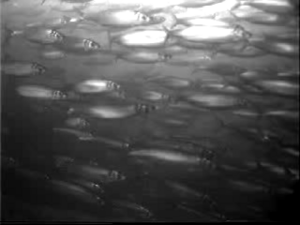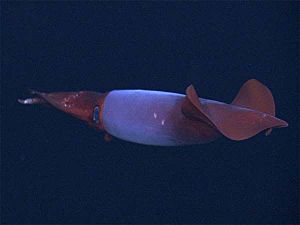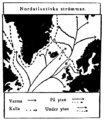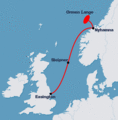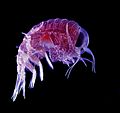Norwegian Sea facts for kids
Quick facts for kids Norwegian Sea |
|
|---|---|
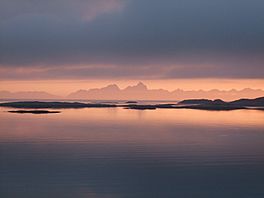
The Vestfjorden with the mountains of the Lofoten archipelago seen from Løvøy Island in Steigen. Vågakaillen (942 m) is the taller of the two peaks in the centre of the image.
|
|

The Norwegian Sea is outlined in red (Europäisches Nordmeer in German)
|
|
| Coordinates | 69°N 2°E / 69°N 2°E |
| Type | Sea |
| Basin countries | Norway, Iceland |
| Surface area | 1,383,000 km2 (534,000 sq mi) |
| Average depth | 2,000 m (6,600 ft) |
| Max. depth | 3,970 m (13,020 ft) |
| Water volume | 2,000,000 km3 (1.6×1012 acre⋅ft) |
The Norwegian Sea is a large part of the North Atlantic Ocean. It is located northwest of Norway. This sea sits between the North Sea and the Greenland Sea. To the west, it connects with the main Atlantic Ocean, and to the northeast, it meets the Barents Sea.
Unlike many other seas, most of the Norwegian Sea's bottom is very deep. It is not part of a continental shelf, which is the shallow edge of a continent. The average depth is about two kilometers (1.2 miles). Under the seabed, there are large amounts of oil and natural gas. These resources are being collected for commercial use.
The coastal areas of the Norwegian Sea are full of fish. These fish come from the North Atlantic to the Norwegian Sea to lay their eggs. A warm ocean current called the North Atlantic Current keeps the water warm and stable. This means the Norwegian Sea stays free of ice all year round, unlike other Arctic seas.

Contents
Life in the Norwegian Sea
The Norwegian Sea is a special place where cold Arctic conditions meet warmer boreal conditions. This means you can find plants and animals from both regions here. Many Arctic species reach their southern limit in this sea. At the same time, many boreal species reach their northern limit here. This creates an overlap zone where different species live together. Some animals, like the scallop Chlamys islandica and capelin, prefer to live in this mix of Atlantic and Arctic waters.
Tiny Organisms and Sea Bottom Life
Most of the living things in the Norwegian Sea are found in the upper layers of the water. Only a small part of the total life is found deeper than 1,000 meters (3,280 feet) or near the seafloor.
The growth of tiny plant-like organisms, called phytoplankton, is highest around May 20th. The main types of phytoplankton are diatoms, especially Thalassiosira and Chaetoceros. After this spring growth, other tiny organisms called haptophytes, like Phaecocystis pouchetti, become more common.
Tiny animal-like organisms, called zooplankton, are mostly copepods such as Calanus finmarchicus and Calanus hyperboreus. C. hyperboreus is more common in the colder Arctic waters. These copepods are a main food source for many sea animals. Important krill species, which are small shrimp-like creatures, include Meganyctiphanes norvegica, Thyssanoessa inermis, and Thyssanoessa longicaudata. Unlike the Greenland Sea, the Norwegian Sea has many plankton with calcium carbonate shells, like coccolithophores and Globigerinida.
Shrimp, especially Pandalus borealis, are a key food source for fish like cod and blue whiting. A unique feature of the Norwegian Sea is its large coral reefs made of Lophelia pertusa. These reefs provide a safe home for many different fish species.
Fish and Their Life Cycles
The coastal waters of Norway are very important for herring. Many herring populations in the North Atlantic come here to lay their eggs in March. The eggs float to the surface and are carried away from the coast by currents flowing north. Most young herring spend their summer in the Barents Sea, where they eat a lot of plankton. When they grow up, they return to the Norwegian Sea.
The number of herring changes a lot each year. It grew in the 1920s because of warmer weather. But then it dropped sharply until the 1970s, partly because too many were caught. The number of young herring fell from 11 million tons in 1956 to almost none by 1970. This greatly affected the entire ecosystem of both the Norwegian Sea and the Barents Sea.
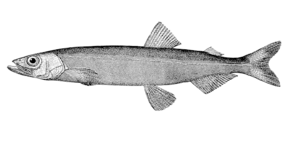
Rules to protect the environment and control fishing have helped herring populations recover since 1987. However, this recovery also led to fewer capelin and cod. While capelin benefited from less fishing, warmer temperatures in the 1980s and competition for food with the herring caused young capelin to almost disappear from the Norwegian Sea. Older capelin were also quickly fished out. This also reduced the number of cod, which eat capelin, because there weren't enough herring yet to replace capelin in the cod's diet.
Blue whiting (Micromesistius poutassou) have done well as herring and capelin numbers dropped. They became the main fish eating plankton. Blue whiting lay their eggs near the British Isles. Ocean currents carry their eggs to the Norwegian Sea, and adult blue whiting also swim there to find food. Young blue whiting spend their summer and winter in Norwegian coastal waters before returning to warmer waters west of Scotland.
The Norwegian Arctic cod mainly lives in the Barents Sea and near the Svalbard Archipelago. In the rest of the Norwegian Sea, they are only found during their breeding season near the Lofoten Islands. Other fish like Pollachius virens and haddock lay their eggs in coastal waters. Mackerel is also an important fish caught for food. The coral reefs are home to different species of fish from the genus Sebastes.
Mammals and Birds
Many large whales live in the Norwegian Sea, including minke, humpback, sei, and orca whales. White-beaked dolphins are found in the coastal waters. Orcas and some other whales visit the sea in the summer to feed. They follow the schools of herring. Minke whales are the most common whales, with about 110,000 in total. Norway and Iceland hunt them, with Norway having a limit of about 1,000 per year. Today, they are mostly hunted for their meat.
The bowhead whale used to live in this area but almost disappeared after a lot of whaling in the 1800s. It was even gone from the entire North Atlantic for a while. Similarly, blue whales used to form large groups between Jan Mayen and Spitsbergen, but they are rarely seen now. It is also rare to see northern bottlenose whales in the Norwegian Sea. Other large animals in the sea include hooded and harp seals, and squid.
Important seabirds that live in the Norwegian Sea are puffins, kittiwakes, and guillemots.
Images for kids
-
Vedøya, Skumvær and Røst islands, Lofoten, Norway
-
Tide ranges and tide times (hours after Bergen) along the Norwegian coast
-
Traditional cod stand
-
Arctic whaling (18th century). The ships are Dutch and the animals are bowhead whales. Beerenberg on Jan Mayen Land can be seen in the background.
-
The Carta Marina (1539) by Olaus Magnus is the earliest detailed map of the Nordic countries. Note various sea monsters on the map.
-
Illustration by Harry Clarke (1889–1931) for Edgar Allan Poe's story "Descent into the Maelstrom," published in 1919.
See also
 In Spanish: Mar de Noruega para niños
In Spanish: Mar de Noruega para niños


